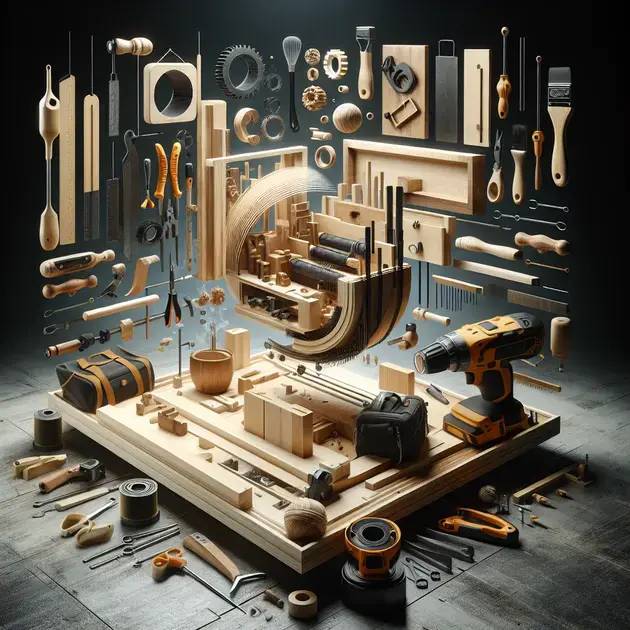Are you a beginner looking to delve into the world of woodworking and craft beautiful creations? Look no further, as this woodworking guide is tailored for beginners like you. Crafting Beautiful Creations: Woodworking Guide for Beginners will take you through the fundamentals of woodworking, providing step-by-step instructions to kickstart your woodworking journey.
Woodworking is a timeless craft that allows individuals to unleash their creativity and create functional pieces of art. In this comprehensive guide, you will learn essential woodworking techniques, safety precautions to follow, and the necessary tools to have in your woodworking arsenal. Whether you’re interested in building furniture, decor pieces, or small wooden crafts, this guide will set you on the path to becoming a woodworking pro.

Essential Woodworking Basics for Beginners
Woodworking is a fantastic hobby that allows you to create beautiful and functional pieces of furniture and décor. If you are just starting out, here are some essential woodworking basics for beginners to help you get started:
Safety First: Woodworking Precautions
When it comes to woodworking, safety should always be your top priority. Follow these precautions to ensure a safe woodworking experience:
1. Always wear appropriate safety gear, such as safety goggles, a dust mask, and ear protection.
Use a reliable source like the Occupational Safety and Health Administration (OSHA) website to find information on the recommended safety gear for woodworking.
2. Keep your work area clean and well-organized to reduce the risk of accidents.
Check out woodworking forums like WoodNet Forums for tips on organizing your workspace efficiently.
3. Familiarize yourself with the proper way to handle woodworking tools and equipment.
Watch tutorial videos on YouTube channels like Wood Workers Guild of America to learn the correct techniques for using woodworking tools.
4. Avoid distractions while working with power tools to prevent injuries.
Use productivity apps like Forest to help you stay focused and avoid distractions during your woodworking sessions.
5. Take breaks regularly to prevent fatigue and maintain focus on your woodworking projects.
Install a time-tracking app like Toggl to schedule breaks and ensure you are working efficiently without overexerting yourself.
Building Your Woodworking Tool Collection
As a beginner woodworker, building your woodworking tool collection is an exciting step. Here’s a guide to help you start your collection:
1. Begin with essential hand tools like a hammer, tape measure, chisels, and hand saws.
Visit woodworking websites such as Woodcraft to find high-quality hand tools for beginners at affordable prices.
2. Invest in a good quality cordless drill and a set of drill bits for your woodworking projects.
Check out online retailers like Amazon for highly rated cordless drills and drill bit sets from trusted brands.
3. Purchase a reliable table saw to make accurate cuts in your woodworking projects.
Read customer reviews on sites like Home Depot to find a table saw that fits your budget and requirements.
4. Add a versatile router to your collection for shaping edges and creating intricate designs.
Explore woodworking magazines like Fine Woodworking for recommendations on the best routers for beginners.
5. Consider adding a woodworking workbench to your collection for a sturdy and dedicated workspace.
Visit woodworking specialty stores like Rockler to find a variety of workbenches that suit your space and budget.

Avoiding Common Mistakes in Woodworking
Woodworking can be a satisfying and fulfilling hobby, but it’s essential to avoid common mistakes to ensure your projects turn out as intended. One common mistake to avoid is not properly measuring and marking your wood before cutting. Taking the time to measure accurately and mark your cuts can save you from costly errors and wasted materials. Additionally, not using sharp tools is another mistake to steer clear of. Dull tools can result in rough cuts and splintered wood, affecting the overall quality of your project.
To avoid mistakes, it’s crucial to pay attention to detail and follow a plan or blueprint carefully. Rushing through a project or skipping important steps can lead to errors that may be difficult to correct later on. Another common mistake is neglecting to sand your wood properly before finishing. Sanding helps smooth out imperfections and prepares the surface for a flawless finish.
Furthermore, overlooking the importance of safety precautions is a mistake that should never be made. Wearing appropriate safety gear, such as goggles and gloves, and using tools properly can prevent accidents and injuries. Lastly, not practicing patience in woodworking can lead to mistakes. Take your time with each step of the project, and don’t rush the process to ensure the best possible results.
Creating Stunning Woodwork Projects
When it comes to creating stunning woodwork projects, attention to detail and craftsmanship are key. Begin by selecting high-quality wood that suits your project’s requirements and desired aesthetics. Choosing the right type of wood can significantly impact the outcome of your project. Additionally, investing in good tools and maintaining them properly is crucial for achieving professional results.
One essential aspect of creating stunning woodwork projects is incorporating unique design elements and features. Adding intricate details or personalized touches can elevate your project from ordinary to extraordinary. Experimenting with different techniques, such as carving or inlay work, can also enhance the visual appeal of your woodworking projects.
Furthermore, paying close attention to the finishing touches is vital in creating stunning woodwork projects. Whether it’s applying a smooth finish or adding decorative accents, the final details can make a significant difference in the overall appearance of your project. Lastly, don’t underestimate the power of practice and perseverance. Continuously honing your skills and pushing your creative boundaries can lead to truly remarkable woodwork projects.
Mastering Woodworking Joints and Techniques
Mastering woodworking joints and techniques is essential for creating strong and durable woodwork projects. Begin by familiarizing yourself with the various types of woodworking joints, such as dovetail, mortise and tenon, and finger joints. Understanding when and how to use each type of joint can significantly improve the structural integrity of your projects.
Practice precision and consistency when cutting and assembling joints to ensure a tight fit and seamless finish. Taking the time to refine your woodworking techniques, such as planing and chiseling, can make a significant difference in the quality of your joints. Additionally, exploring advanced woodworking techniques, such as bending wood or creating complex joinery, can expand your creative possibilities.
Another crucial aspect of mastering woodworking joints is ensuring proper alignment and gluing. Misaligned joints or insufficient glue coverage can weaken the integrity of your projects. It’s essential to follow best practices for gluing and clamping joints to achieve strong and long-lasting results. Lastly, don’t hesitate to seek guidance from experienced woodworkers or invest in educational resources to enhance your knowledge and skills in mastering woodworking joints and techniques.
Conclusion
In the world of woodworking, avoiding common mistakes is paramount to the success of your projects. Ensuring accurate measurements and using sharp tools can prevent costly errors and enhance the quality of your work. Remember to pay attention to detail, follow a plan meticulously, and take your time with each step to achieve optimal results.
When creating stunning woodwork projects, craftsmanship and attention to detail take center stage. Selecting high-quality wood, investing in good tools, and incorporating unique design elements can elevate your projects from ordinary to extraordinary. Don’t underestimate the impact of finishing touches and continuous practice in honing your skills.
Mastering woodworking joints and techniques is crucial for building durable projects. Familiarize yourself with different joint types, practice precision in cutting and assembly, and ensure proper alignment and gluing for strong results. By exploring advanced techniques and seeking guidance when needed, you can enhance your woodworking skills and create projects that stand the test of time.